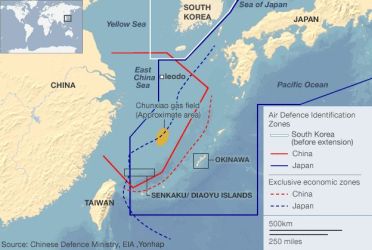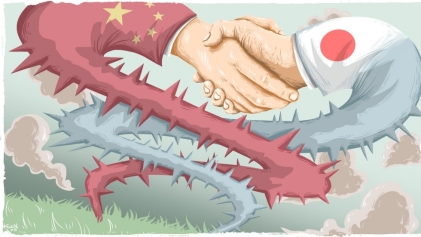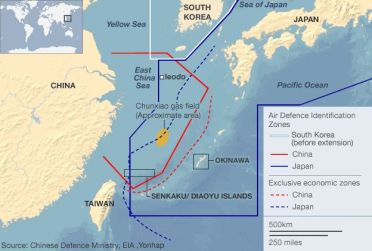China and Japan, world’s two of the largest economies, have relations which are of utmost importance and very sensitive. The high level of trade between the two countries fails to give the true impression, which is an underlying and long-standing tension. The dynamics of these two countries have changed overtime. There was a time when Japan over-ruled China, which marked the beginning of China-Japan conflict. As China is rising quickly, the conflict continues.
After the success of Japan in the first Sino-Japanese war in 1895 and signing of the Treaty of Shimonoseki (peace treaty to end the war), Japan was considered an emerging world power. The war led to decline in China’s Qing dynasty. Post the war Japan constantly focused on expanding its military and naval base through modernization and industrialization. With the expansion of Japan, it gained control of Taiwan after defeating China in the first Sino-Japanese war. By 1910, Japan had also taken control over the Korean peninsula. At the beginning of the World War I, Japan joined the allied forces and made advances towards occupying China. While European countries were heavily involved in the world war, Japan sought to consolidate its position in China by presenting twenty-one demands, which extended Japan’s influence over Chinese economy to an extent. During the war, Japan succeeded to occupy the German colonies in China. Japan’s economy flourished during this time as exports quadrupled from 1913 to 1918 and its influence kept on growing in China. At the start of 1920s, Japan was in a good shape, its economy was growing and they had expanded their influence into the mainland Asia through China and Korea. During the 1920s militarists gained management in Japan’s government. Their aim was to use force to increase Japanese influence into China, which had been weakened by revolution. Japan conjointly needed to expand its territories each to alleviate its downside of overpopulation and to gain badly required natural resources.
In the 1930s, Japanese troops blew up a section of the railway under its control near Shenyang, then accused Chinese troops of sabotaging as a pretext and bombarded the barracks of the Chinese troops close to Moukden the same evening, thus starting a large-scale armed invasion of northeast China. Four months later, Japanese troops occupied 1.28 million km of Chinese territory in northeast China, 3.5 times the land mass of the whole of Japan. The incident was followed by Japan’s complete invasion of China and also remaining parts of Asia, and triggered a 14-year war of resistance against Japanese aggression. Japan continued to invade and occupy parts of China like Manchuria. In 1937, the second Sino-Japanese war began with the Marcoo polo bridge incident where the Chinese troops attacked the Japanese military on the bridge. During the battle, Japanese troop advanced towards the southern and western parts of China and events like Japanese war crimes and Nanking massacre took place in China. The continuous conflicts between China and Japan led to pressure on China to sign various agreements in Japan’s benefits like demilitarization in Shanghai and many others. The Japanese advances eventually limited due to Chinese tactics. At the end of world war 2 (in 1945) and atomic attack on Hiroshima and Nagasaki and the Soviet invasion of Japanese occupied Chinese territory, Japan lost the war and surrendered, which led to a downfall of the country’s power. Japan also lost the control over Taiwan, which was then administered by China, after Japan’s surrender.
In 1949, the People’s Republic of China was established, after which the Sino-Japanese relations changed. Japan’s military power had weakened from the defeat in the world war. China still viewed Japan as a potential enemy and considered it a threat. China signed a friendship and alliance treaty with the Soviet Union and Japan signed a mutual co-operation and security treaty with the United States. These treaties put both China and Japan on the opposite sides of each other during the cold war, deteriorating their relations even more. The dispute grew deeper in 1952 when Japan concluded a treaty a peace treaty with Republic of China (aka Taiwan) and established diplomatic relations with Taiwanese authorities. In the 1960s, the trade relations between China and Japan improved with installment of Chinese synthetic textile manufacturing unit in Japan in 1963. Sino-Japanese ties declined once more throughout the Great Proletarian Cultural Revolution and also decline was more exacerbated by Japan’s growing strength and independence from the United States within late 1960s. China was especially concerned that Japan might re-militarize to compensate for the reduced United States military presence in Asia. However, Japan adopted a move forward in its relations with China. In 1971, the Chinese and Japanese trade liaison offices began to restore diplomatic trade relations and in September 1972, both the countries signed a joint statement, which established the diplomatic relations between both the countries. Post the joint statement (aka joint communique) the bilateral economic and trade missions grew rapidly.

In April 1978, a dispute over the territory of the Senkaku Islands (aka Diaoyu Islands), began and threatened the diplomatic ties of China and Japan. However, the peace talks resumed and an agreement called the Treaty of Peace and Friendship between Japan and People’s Republic of China was signed on 12 August 1978. Japan has been China’s largest commercialism partner since the mid-1960s, accounting for more than 20 percent of China’s total trade. Bilateral trade exploded in the 1970s and early 1980s, from US$1 billion in the early 1970s to more than US$8 billion in 1982. Japan became China’s largest creditor, accounting for nearly half of the estimated US$30 billion in credit China lined up from 1979 to 1983.The 1980s was marked as a golden age as considerable progress was made in terms of the china-japan relations. Japan was heavily involved with China’s economic modernization. With rise in Soviet Union’s military presence in Afghanistan, Vietnam etc., Japan and China adopted complementary foreign policies designed to isolate the Soviet Union and its allies politically and to promote regional stability. During this time, China and Japan both played a major role in backing strong diplomatic ties within Southeast Asian countries (Vietnam, Thailand and Cambodia), Northeast Asian countries (South Korea and North Korea) and acted against the rise of Soviet Union in Asia. Tension erupted occasionally, however, over trade and technology issues, Chinese concern over potential Japanese military resurgence, and controversy regarding Japan’s relations with Taiwan, especially Beijing’s concern that Tokyo was pursuing a “two Chinas” policy. Alternatively, China joined Asian nations in criticizing Japanese history textbooks that deemphasized past Japanese aggression, claiming that the distortion was evidence of the rise of militarism in Japan. By the late 1980s, despite occasional outbreaks of tension, the two governments commanded regular consultations, high-level leaders often exchanged visits, Chinese and Japanese military leaders had begun contacts. Due to this, there were resolutions of situations through increased dialogues and summits. However, the Tiananmen Square massacre of 1989, in which hundreds of pro-democracy protesters were killed, dramatically changed the Japanese public’s perception of China but Japan was the first country to resume Official Development Assistance (ODA) to China after imposing several sanctions.
From 1990s we can see a change in the dynamics and the relations becoming more competitive and volatile. The public opinion continued a downward spiral. With the disintegration of Soviet Union, both China and Japan intended in filling up the position of Asian power. During this time, China experienced enormous growth in its economy whereas Japan experienced a stagnant economy, declined economic power and faced much criticism for not including its human resources during the gulf war (in 1991). The Chinese economy gained strength since 1992 when enormous foreign direct investments (FDI) started flowing in from across the globe. The economic influence of China increased in Asia whereas Japan’s influence declined with decrease in Japan’s FDI. Bilateral relations were at peace in the beginning of 1990s, but it started to deteriorate from the mid- 1990s, marked by renewed political disputes over sovereignty and mutual public perceptions. While economic interdependence deepened, political relation deteriorated from mid- 1990s, Chinese protests against Japan were largely suppressed over the territorial issues of Senkaku/ Diaoyu Islands and military deployment towards Taiwan. In addition to China’s growing economy, the nuclear testing conducted by China in 1995, even though it was a nuclear power since 1964, threatened Japan’s economy as well as military power. In response to the nuclear tests, Japan froze ODA as a sanction against China. From here on there can be seen a complete change in China-Japan relations, as China grew exponentially and Japan’s growth remained stagnant. Up until now, Japan had the upper hand, which started to change from 1990s as China started to grow influence over Asian region, which threatened the long-standing Japanese influence over the Asian region. At the end of the 20th century Japan signed a bilateral security alliance with US, which also included issues concerning the Taiwan Strait, which alarmed China.

The countries entered the 21st century by issuing a Japan-China Joint Declaration on Building a Partnership of Friendship and Co-operation for Peace and Development and Joint Press Announcement on Strengthening Cooperation between Japan and China towards the 21st Century. The idea was to have the political foundation for a cordial trade and economic relations, to achieve common interests and enhance their economies. However, in the 21st century, Japan enhanced security co-operation with the help of the US, which compromised China’s security interest. Japan’s 2004 Defense Planning Guidelines focused on remaining attentive towards the ongoing Chinese military modernization and its expanding maritime operations. In 2005, violent anti-Japanese riots erupted in China in response to the new textbooks published by Japanese government, which attempted to wash out the past (Japanese war crimes in China). Nonetheless in 2006, when Prime Minister Shinzo Abe’s government came into office for a brief period both the countries worked to repair and stabilize the bilateral relationship. The two sides resolved to face history squarely, advance towards the future and endeavor with persistence to create a new era of mutually beneficial relationship based on common strategic interest between the countries while issuing a joint statement in 2008. However, in 2010, an incident near the disputed Senkaku (Diaoyu) islands occurred where a Chinese fishing trawler operating within Japan’s exclusive economic zone in the disputed region collided with two Japanese coast guard ships. Due to this the 2008 agreement of jointly developing resources near these islands was frozen, which gave rise to tensions between these two countries. The issue of disputed islands intensified two years later, when Japan purchased three of the five islands from a private owner in 2012. Political and diplomatic relations and dialogues went into deep freeze and large-scale anti-Japanese riots spread throughout China. However, China started increasing its presence in the East China Sea around Senkaku/Diaoyu islands by declaring East China Sea Air defense identification zone (aka ADIZ) in November 2013. (ADIZ is airspace over land or water in which ready identification, location and control of civil aviation over land or water is required in the interest of national security). This heightened Japan’s security concerns with regard to ‘grey zone’ situations.
To address Japan’s increasing security concerns, US President Barack Obama in April 2014 made it clear that Article 5 of the US–Japan Alliance extended to the Senkaku/Diaoyu islands. This was a major blow to Chinese efforts to drive a wedge into the alliance over the Senkaku/Diaoyu issue. At the same time, Japanese direct investment into China’s slowing economy plunged, down nearly 50 per cent in 2014 and a further 16 per cent in the first half of 2015. Over the course of 2014, diplomats in Tokyo and Beijing explored paths towards accommodation that both Prime Minster Abe and Chinese President Xi Jinping could accept. During the Asia-Pacific Economic Co-operation (APEC) meet leaders of both the countries took first step towards improving bilateral relations and returning to the core of mutually beneficial relationship based on common strategic interests. However, the worsening political relations caught up and Japan’s China business went on a sharp decline in 2015 and 2016. Nevertheless, in 2017 the Japanese exports to China flourished with a soaring 20.5 percent whereas Chinese exports increased by 5 percent. Relations between Japan and China improved in the wake of US-China trade war as Japan also has certain trade disputes with US. The trade war between US and China has actually helped improve China and Japan bilateral relations. Under the framework of the Belt and Road Initiative, which yielded the most fruitful and desired results during Prime Minister Shinzo Abe’s visit, and 52 deals totaling more than $18 billion were signed. This has created additional space for coordination and cooperation.
The territorial issue continues to be a major area of conflict or dispute even today but the trade and economic relations are improving as the two countries accept the inter-dependence of their economies. In my opinion, China and Japan’s strained relationship goes back to a long history nevertheless; the two countries have demonstrated the ability to put history on the back burner in order to address immediate needs. Despite security concerns, both the economies are fueled by each other. According to me, as both China and Japan will enter into higher economic development, they will need to strengthen their economic ties to inject higher trade. If we look at the trend of Japan-China relation, even after having serious territorial and other issues, the countries have found a way to return to enhancing trade and economic relations due to common interests. China and Japan have a deeply tangled economic relationship. China is Japan’s second largest export market; Japan is China’s third largest export market. Besides the linkages in the two economies, both China and Japan derive a substantial portion of their exports and imports, especially of various raw materials. This means that both China and Japan are dependent on free navigation of the sea-lanes that make these imports and exports possible. According to me, this helps both the sides to put aside the history and flourish their economies through mutually understood moves. In addition, the strength and continuous rise of Chinese economy and the events near the territory of Senkaku/Diaoyu islands will largely determine the regional order in Asia, which will also play a major role in determining the future course of China and Japan relations.

Leave a comment